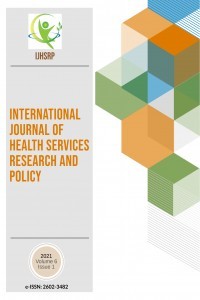THE OPERATIVE TREATMENT OUTCOMES OF CHRONIC HINDFOOT PAIN WITH POSTERIOR ANKLE ENDOSCOPY
THE OPERATIVE TREATMENT OUTCOMES OF CHRONIC HINDFOOT PAIN WITH POSTERIOR ANKLE ENDOSCOPY
Hindfoot posterior ankle, endoscopy,
___
- 1. Hamilton, W.G., Geppert, M.J., Thompson, F.M. Pain in the posterior aspect of the ankle in dancers. Differential diagnosis and operative treatment. J Bone Joint Surg Am, 78(10):1491–1500 14, 1996. Doi: 10.2106/00004623-199610000-00006.
- 2. Hedrick, M.R, McBride, A.M. Posterior ankle impingement. Foot Ankle Int, 15(1):2–8, 1994. Doi: 10.1177/107110079401500102.
- 3. van Dijk, C.N. Hindfoot arthroscopy. Foot Ankle Clin, 11(2):391–414, 2006. Doi: 10.1016/j.fcl.2006.03.002.
- 4. Abramowitz, Y., Wollstein, R., Barzilay, Y., et al. Outcome of resection of a symptomatic os trigonum. J Bone Joint Surg Am, 85:10511057, 2003. Doi: 10.2106/00004623-200306000-00010.
- 5. Bulstra, G.H., Olsthoorn, P.G., van Dijk, C. N. Endoscopy of the posterior tibial tendon. Foot Ankle Clin, 11(2):421–427 2, 2006. Doi: 10.1016/j.fcl.2006.03.001.
- 6. Chow, H.T., Chan, K.B., Lui, T.H. Tendoscopic debridement for stage I posterior tibial tendon dysfunction. Knee Surg Sports Traumatol Arthrosc, 13(8):695–698, 2005. Doi: 10.1007/s00167-005-0635-8.
- 7. Williams, M.M., Ferkel, R.D. Subtalar arthroscopy: Indications, technique, and results. Arthroscopy Mar; 20(1):93-108., 1998. Doi: 10.1016/j.fcl.2014.10.010.
- 8. Hamilton, W.G. Stenosing tenosynovitis of the flexor hallucis longus tendon and posterior impingement upon the os trigonum in ballet dancers. Foot Ankle, Sep-Oct; 3(2):74-80, 1982. Doi: 10.1177/107110078200300204.
- 9. Lawson, J.P. extremities. Radiology, Dec; 157(3):625-31, 1985. Doi: 10.1148/radiology.157.3.4059550
- 10. Jesus, V., Jordi, V., Maria, M., et. Al.Hindfooft endoscopy for the treatment of posterior ankle impingement syndrome: A safe reproducible technique. Foot and Ankle Surgery, Sep; 20(3):174-9, 2014. Doi: 10.1016/j.fas.2014.03.002
- 11. Tey, M., Monllau, J.C., Centenera, J.M., Pelfort, X. Benefits of arthroscopic tuberculoplasty in posterior ankle impingement syndrome. Knee Surg Sports Traumatol Arthrosc, Oct; 15(10):1235-9, 2007. Doi: 10.1007/s00167-007-0349-1
- 12. Scholten, P.E., Sierevelt, I.N., van Dijk, C.N. Hindfoot endoscopy for posterior ankle impingement. J Bone Joint Surg Am, 90(12):2665–2672, 2008. Doi: 10.2106/JBJS.F.00188.
- 13. Tahir, O., Egemen, A., Kaan, I, Abdullah, I.S., Endoscopic treatment of posterior ankle pain.Knee Surg Sports Traumatol Arthrosc, 19:1355–1361, 2011. Doi: 10.1007/s00167-011-1428-x
- 14. Holm, C.L. Primary synovial chondromatosis of the ankle. A case report. J Bone Joint Surg Am, Sep; 58(6):878-80, 1976.
- 15. Amendola, A., Petrik, J., Webster-Bogaert, S. Ankle arthroscopy: outcome in 79 consecutive patients. Arthroscopy 12(5):565–573, 1996. Doi: 10.1016/s0749-8063(96)90196-6.
- 16. Spennacchio, P., Cucchid, R.P., van dijk, N.C. Evidence-based indications for hindfoot endoscopy. Knee Surg Sports Traumatol Arthrosc, Apr; 24(4):1386-95, 2016. Doi: 10.1007/s00167-015-3965-1
- 17. Feiwell, L.A., Frey, C. Anatomic study of arthroscopic portal sites of the ankle. Foot Ankle, 14(3):142-147, 1993. Doi: 10.1177/107110079301400306.
- 18. Nickisch, F., Barg, A, Saltzman, C.L. Postoperative complications of posterior ankle and hindfoot arthroscopy. J Bone Joint Surg Am, Mar 7; 94(5):439-46, 2012.Doi: 10.2106/JBJS.K.00069.
- 19. Ferkel, R.D., Heath, D.D., Guhl, J.F. Neurological complications of ankle arthroscopy. Arthroscopy. Apr; 12(2):200-8, 1996. Doi: 10.1016/s0749-8063(96)90011-0.
- Yayın Aralığı: Yılda 3 Sayı
- Başlangıç: 2016
- Yayıncı: Rojan GÜMÜŞ
THE OPERATIVE TREATMENT OUTCOMES OF CHRONIC HINDFOOT PAIN WITH POSTERIOR ANKLE ENDOSCOPY
PERCEPTIONS OF CONSCIENCE OF NURSING STUDENTS ACCORDING TO EMPATHY LEVELS
Hediye UTLİ, Leyla ZENGİN AYDIN
THE EFFECT OF SPIRITUAL WELL-BEING ON SURGICAL FEAR IN PATIENTS SCHEDULED TO HAVE ABDOMINAL SURGERY
Gürkan KAPIKIRAN, Bilsev DEMİR, Semra BÜLBÜLOĞLU, Serdar SARITAŞ
NURSES’ PERCEIVED AND ACTUAL PREPAREDNESS FOR DISASTERS
RISK ASSESSMENT FOR WORK HEALTH AND SAFETY: A UNIVERSITY DINING HALL
Derya ŞİMŞEKLİ BAKIRHAN, Sinan İRTEGÜN, Özlem Doğan YÜKSEKOL
THE SYMPTOMS AND CO-MORBIDITIES OF COVID-19 PATIENTS AT HOME ISOLATION IN INDIA
Sujata MURARKAR, Sudhanshu MAHAJAN, Jayashree GOTHANKAR
COMPARISON OF HEALTHCARE SYSTEM PERFORMANCES IN OECD COUNTRIES
Serkan ORAL, Bulat Aytek ŞIK, Özkan ÖZDAMAR, Yaşam Kemal AKPAK, Yılda Arzu ABA
